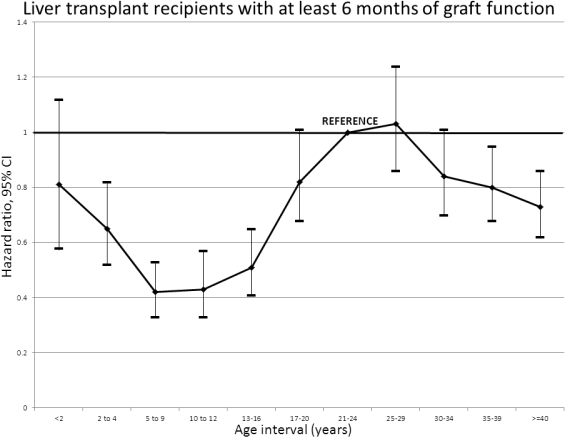Age-Specific Graft Failure Rates in Pediatric Liver Transplant Recipients
1Pediatrics, Research Institute of the McGill Univ. Health Centre, Montreal, QC, Canada
2Pediatrics, Washington Univ., St. Louis, MO, Central African Republic
3Pediatrics, Stollery Children's Hospital, Edmonton, AB, Canada
4Transplant and Regenerative Medicine Center, Hospital for Sick Children, Toronto, ON, Canada.
Meeting: 2015 American Transplant Congress
Abstract number: D196
Keywords: Age factors, Graft failure, Mortality, Pediatric
Session Information
Session Name: Poster Session D: Liver: Pediatrics
Session Type: Poster Session
Date: Tuesday, May 5, 2015
Session Time: 5:30pm-6:30pm
 Presentation Time: 5:30pm-6:30pm
Presentation Time: 5:30pm-6:30pm
Location: Exhibit Hall E
Graft failure risk peaks during emerging adulthood (18-25 y) in kidney transplant recipients. The association between age and graft failure risk in liver transplant recipients is unknown; differences may exist between organ types. We sought to estimate both age-specific graft failure rates and the relative hazards of graft failure at different ages (compared with at 21-24 years old) among young liver transplant recipients who had at least 6 months of graft function. We evaluated 17,181 patients recorded in the Scientific Registry of Transplant Recipients database who received a first liver transplant at <40 years old (1988-2012); 9885 (58%) were <25 years at transplant. Time-dependent Cox models with time-varying covariates were used to estimate the association between age (time-dependent) and the risk of graft failure (defined as death after graft failure or re-transplant). Models included sex, race, era, socioeconomic status, insurer, comorbidity, and primary diagnosis. There were 2541 graft failures over a median follow-up of 6.8 years (IQR 3.0 – 11.9) years. Crude age-specific graft failure rates were highest in 21-24 year-olds (2.7 per 100 person-years). Compared to 21-24 year-olds with the same time since transplant, graft failure rates were significantly lower in 2 to 16 year-olds and in those ≥35 years old; failure rates were almost identical in 25-29 year-olds (HR 1.03 [95%CI 0.86, 1.24]), and lower, but not significantly different, in 17-20 and 30-34 year olds.  Sensitivity analyses excluding individuals with primary diseases at risk for recurrence that occur in adults but not children (or vica versa) returned similar results. Among first liver transplant recipients <40 years old, graft failure risks were highest between 21 and 29 years old.
Sensitivity analyses excluding individuals with primary diseases at risk for recurrence that occur in adults but not children (or vica versa) returned similar results. Among first liver transplant recipients <40 years old, graft failure risks were highest between 21 and 29 years old.
To cite this abstract in AMA style:
Foster B, Dahhou M, Zhang X, Dharnidharka V, Conway J, Ng V. Age-Specific Graft Failure Rates in Pediatric Liver Transplant Recipients [abstract]. Am J Transplant. 2015; 15 (suppl 3). https://atcmeetingabstracts.com/abstract/age-specific-graft-failure-rates-in-pediatric-liver-transplant-recipients/. Accessed December 16, 2025.« Back to 2015 American Transplant Congress
